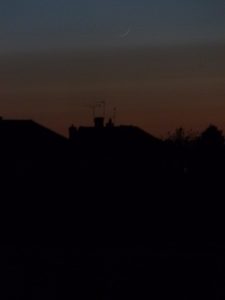A great image of the crescent Moon (with Earthshine) and Jupiter taken on the 14th June 2023 with a Pentax KP 300mm by member Jim Burchell.
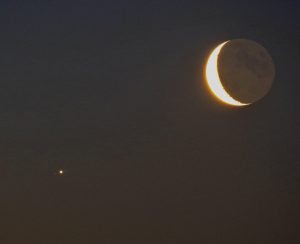
Astronomy every Thursday
A great image of the crescent Moon (with Earthshine) and Jupiter taken on the 14th June 2023 with a Pentax KP 300mm by member Jim Burchell.

John Mason's lecture has now moved from the 29th June to the 13th of July 2023. As John Mason's JWST talk is our closing lecture for the season 2022/23, we would like to open it to all CMHASD members 😊 so do please join us.
Another set of observations for the ExoClock project by member Simon Dawes :-)
Simon wrote ''This was a tricky observation, a bright star with faint comparisons, on the night of the summer solstice - the worst night of the year for astronomy, due to the lack of real night - there were 627 15s exposures which, when processed, works out at about 60Gb of disk space - for a single O-C measurement!''
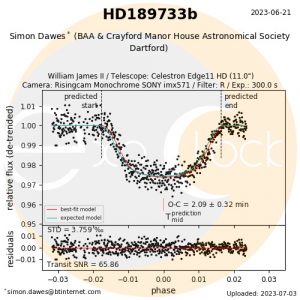
''This far-off blue planet may look like a friendly haven – but don’t be deceived! Weather here is deadly. The planet’s cobalt blue colour comes from a hazy, blow-torched atmosphere containing clouds laced with glass. Howling winds send the storming glass sideways at 5,400 mph (2km/s), whipping all in a sickening spiral. It’s death by a million cuts on this slasher planet!'' Ref:https://exoplanets.nasa.gov/exoplanet-catalog/6876/hd-189733-b/
HD 189733b is an exoplanet approximately 64.5 light-years away in the constellation of Vulpecula. The planet was discovered on October 5, 2005. HD 189733b orbits its host star once every 2.2 days.
The closest transiting hot Jupiter to Earth, scientists have extensively studied the exoplanet's atmosphere. Researchers have found that the planet has an unusual rain of molten glass.
A fantastic collection of images showing the Full Moon also known as the Buck Moon rising on the 3rd July 2023 by member Jim Burchell in the constellation of Sagittarius. All images were taken with a Pentax KP. It was also the 1st Supermoon of 2023.
The full Moon in July is called a Buck Moon after the new antlers that begin to grow from the forehead of a buck (male) deer at this time of year. They shed their antlers in the early spring or late winter, growing full again in July.
This Buck Moon is the first of four Supermoons that will rise this summer 2023 culminating with September's Full Corn Moon on September 28th.
The Moon orbits the Earth in an elliptical shape rather than in a circle, so its distance to us (Earth) varies over time; so there are times in the Moon's orbit when it is closer to the Earth and other times when it is further away. A Supermoon is a phenomenon that occurs when a full Moon takes place at the same time as the perigee; when the Moon is closest to the Earth.
A Supermoon is actually classified when a full Moon is closer than 360,000km to the Earth. This distance is around 21,000km closer than the Moon’s average distance from us of around 384,400km.
The Old Farmer's Almanac which has published astronomical data for many centuries, says the Buck Moon would orbit closer to the Earth than any of the full Moons we have already had this year.
The end of August's full Moon will be the only supermoon closer to the Earth this year, the publication said.
Below are Jim's photos.....
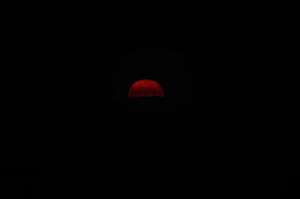
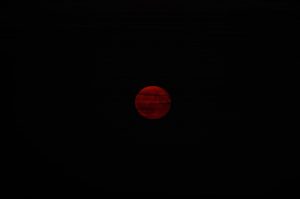
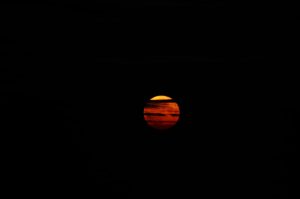
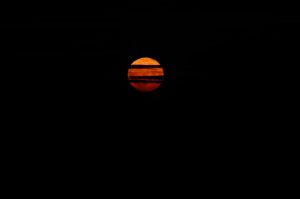
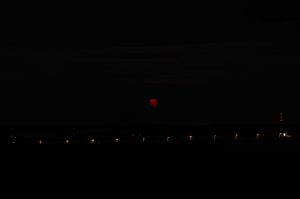
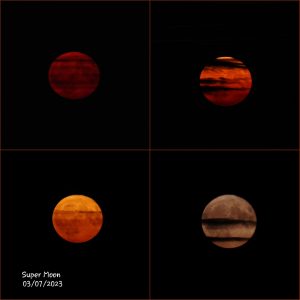
Note that 2024 will have four full Supermoons in a row too. They will occur on August 19, September 18, October 17 and November 15.
NEVER LOOK AT THE SUN DIRECTLY. Please see our Solar Observing safety page at crayfordmanorastro.com/solar-safety/
CMHASD members Jim Burchell, Honor Wheeler and Simon Dawes took the opportunity to observe and image the Sun on Friday 7th July 2023 and below are their super images.
The Sun is very active with many sunspots and one so large it was seen from Mars; yes that is correct - from Mars.
The very large sunspot AR3363 which has just emerged over the Sun's southeastern limb was spotted by the Mars rover Perseverance several days before we did. On July 2nd, the rover's mast-mounted stereo camera MASTCAM-Z tilted up to the sky above Jezaro crater and photographed a deep-black dot on the solar disk. For more information about this; see https://www.spaceweather.com/archive.php?view=1&day=07&month=07&year=2023.
Jim Burchell
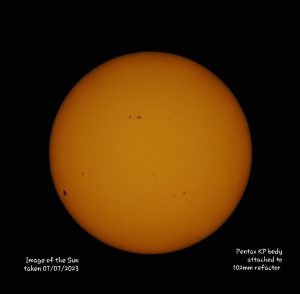
Honor Wheeler
The Sun in Hydrogen Alpha.
Composite of 2 photos one for the disc and one for prominences details, then layered in Snapseed.
Canon M6 Mark II, Coronado PST,
EQ3 Synscan mount, x2 Barlow
ISO200, 1/25s
2023.07.07 12:48UT
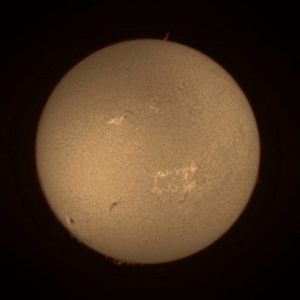
Image enhanced to show some of the Sun's prominences.
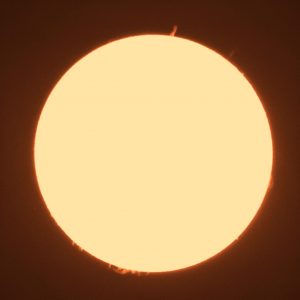
Solar Sunpsots in White light
Canon M6 Mark II, 80mm Refractor, EQ3 Synscan mount, Baader Solar filter, x2 Barlow.
ISO100, 1/800s.
2023.07.07 12:31UT
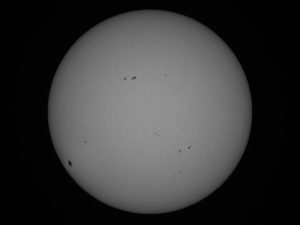
Sunspot AR3363 appearing over the southeastern limb of the Sun.
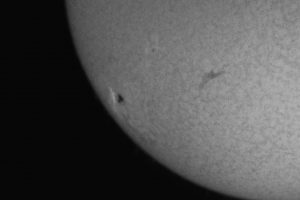
Simon Dawes
Details of how Simon acquired his images are on the photos.
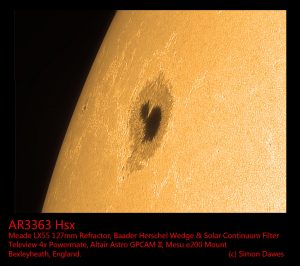

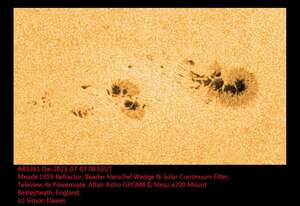
Sun full disk in White light - 12 active regions. Q=30 and R = 225 so pretty active today. Click here to see a full version https://britastro.org/observations/observation.php?id=20230707_113215_4d5fba6e58719cdf
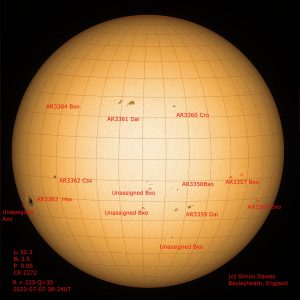
For the latest information about the Sun's activity check out Spaceweather.com
Thursday 6th July was an informal night at the pavilion and some members took the opportunity to do some observing using Honor's PST to observe the Sun & Jo's Newtonian to observe Venus. Thankyou to Chairman John Archer and to Diane Clarke for sharing your photos of the evening.


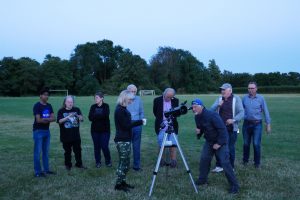
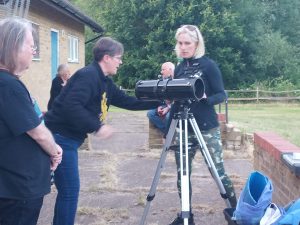
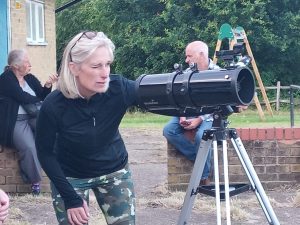
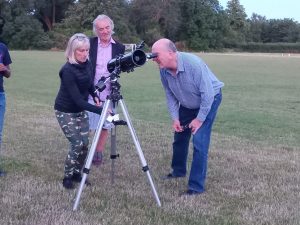
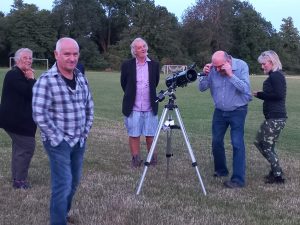
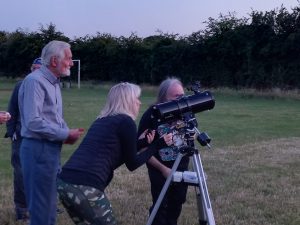
Due to the John Mason lecture being moved to the 29th June, this Thursday is now an informal night. More information may follow.
Look towards the West after sunset for a splendid view of Venus and the crescent Moon over the next few evenings.
Members Jim Burchell and Gary Hunt did yesterday evening the 21st May 2023 and captured these great images of a young crescent Moon with Venus.
Moon & Venus by Jim Burchell
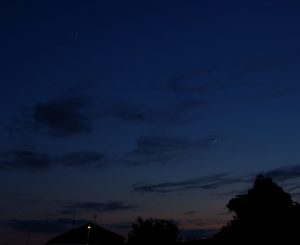
Moon & Venus by Gary Hunt
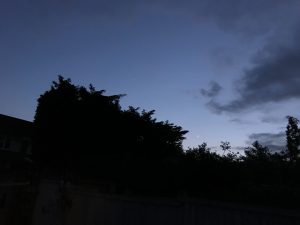
NEVER LOOK AT THE SUN DIRECTLY. Please see our Solar Observing safety page at crayfordmanorastro.com/solar-safety/
The latest images of our active Sun by members Simon Dawes and Jim Burchell.
Simon's 3 images below were taken on the 18th May 2023. Details of how Simon acquired the images are on the photos.
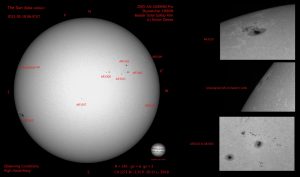
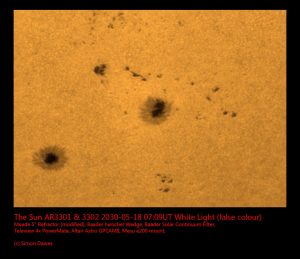
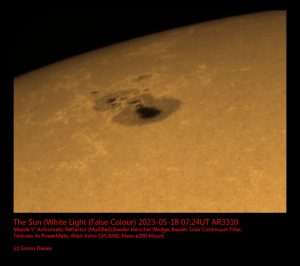
Jim's image was taken on the 21st May 2023
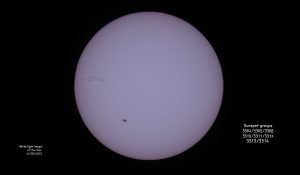
A lovely photo of a young Moon in the constellation Taurus taken by CMHASD trustee John Howarth on the 20th May 2023.
